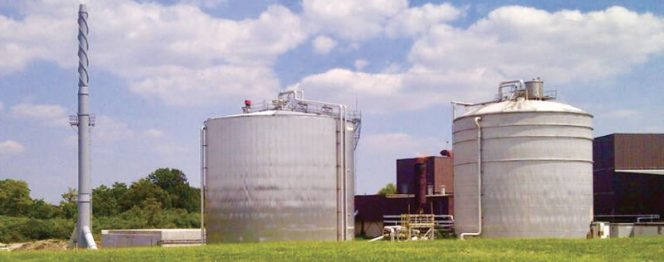BioCycle August 2018
Toronto, Ontario: RNG From Green Bin Organics
The City of Toronto, in partnership with Enbridge Gas Distribution Inc., will begin installing new equipment at the City’s Dufferin Solid Waste Management anaerobic digestion facility later in 2018. The new equipment will enable the City and Enbridge to transform raw biogas produced from processing Toronto’s Green Bin organics into renewable natural gas (RNG) and inject it into the natural gas grid. The first cubic meter (m3) of RNG is expected to be produced by the third quarter of 2019. “This project represents a path to low-carbon fuel for the City and will play an important role in helping us reach our goal of reducing greenhouse gas emissions by 80 percent by 2050,” said Toronto Mayor, John Tory.
The RNG project supports Toronto’s Long Term Waste Management Strategy and move toward a circular economy by using a closed-loop approach in which organics collection trucks are ultimately powered by the waste product they collect. Current estimates suggest that the Dufferin RNG facility will produce approximately 5.3 million m3 of RNG per year — enough to power 132 heavy-duty garbage trucks or about 90 percent of the City’s solid waste collection fleet.
Detroit, Michigan: First Digester At A North American Zoo
Michigan State University (MSU) has created a green solution for what to do with animal and food waste at the Detroit Zoo. MSU researcher Dana Kirk and his team worked with the Detroit Zoo to build the first anaerobic digester at a zoo in North America. The digester is powering the zoo’s animal hospital, which operates at 100 to 150 kilowatts per hour. For reference, a typical household in the United States uses about 900 kilowatts/month of electricity.
Sacramento, California: Biomethane Specifications
The California Council on Science and Technology (CCST) has issued the report “Biomethane in California Common Carrier Pipelines: Assessing Heating Value and Maximum Siloxane Specifications.” When biogas is purified or “upgraded” to biomethane, it can be used interchangeably with fossil natural gas. However, for biomethane to be injected and blended into a “common carrier” natural gas pipeline for transport and distribution, it must match the natural gas in key measurements for gas quality (e.g. heating value), interchangeability (e.g. Wobbe Number), and constituents of concern (e.g. siloxanes).
Assembly Bill 1900 required the California Public Utilities Commission (CPUC) to adopt standards for biomethane that specify the concentrations of constituents of concern as well as requirements for monitoring, testing, reporting, and recordkeeping. This CCST report will help the CPUC reexamine whether two such standards could be updated with scientific evidence: the biomethane minimum heating value adopted in 2006, and the maximum biomethane siloxane concentration adopted in 2014. The study team recommended that the CPUC keep the Wobbe Number minimum requirements as they are now (990 BTU/standard cubic foot (scf)), and that the CPUC initiate a regulatory proceeding to examine the option of allowing biomethane injection with a heating value as low as 970 BTU/scf, provided it satisfies current Wobbe Number limits and all other requirements.
Insufficient evidence is available to determine whether the CPUC maximum siloxane limit of 0.1 mg Si/m3 is too stringent, or not stringent enough, to meet safety requirements. The study team recommended a comprehensive research program to understand the operational, health, and safety consequences of various concentrations of siloxanes, and that the CPUC track ongoing efforts to adopt international standard testing methods for siloxanes.
Olympia, Washington: Manure Management Grants Awarded
The Washington State Conservation Commission (SCC) has awarded $3,880,000 in grants to evaluate innovative technology that will turn manure into nontoxic by-products that can be used on-farm or sold to other markets. Each project will be conducted in partnership with at least one dairy. The request for proposals (issued March 2018) specified that all proposed technology should be cost-effective for dairies of various sizes to use. Technologies and systems to be evaluated include:
• Combined fine solids separator and clean water membrane system. Coproducts from manure treatment include nutrient-rich solid, liquid ammonia/potassium concentrate, and dischargeable clean water.
• Use of worms to convert manure wastewater into irrigation-grade water. Impacts to air and water to be evaluated, along with market options for the “worm tea” generated by the system.
• Vapor Recompression Distillation (VRD) processor to convert manure wastewater in real time into distilled recycled water, concentrated liquid ammonia, and a pathogen-free, dry, organic fertilizer or nutrient product.
• Mobile processing system that turns manure into struvite, a nontoxic, sand-like mineral fertilizer. Use of struvite fertilizer on commercial alfalfa hay operations to develop a regional nutrient recycling relationship will be demonstrated.
• Build on existing digester technologies to achieve nitrogen removal efficiencies and reduce nitrogen concentrations in dairy manure. Includes converting reactive nitrogen to nonreactive nitrogen gas, providing valuable by-products and the potential for new market opportunities for dairies.
All projects will conclude by June 30, 2019 and grant recipients will submit reports of project findings to the SCC. Results from all projects will be compiled into a final report for the Washington State Legislature by December 1, 2020.











